
[Home -> Armin Grewe's Holidays-> Swindon & Wiltshire -> Swindon - Then and Now] [Contact] |
| You might have seen my Historic Swindon page with pictures of Swindon in the 1940s. This page takes the idea a little bit further:
I've taken the pictures James Max Porter took in the 1940s and have tried to take similar pictures of the same places again in September 2006, 60 years later. Some of the places seem to have hardly changed at all, others are very difficult to recognise now. Again we start our little walk in Old Town: |
|
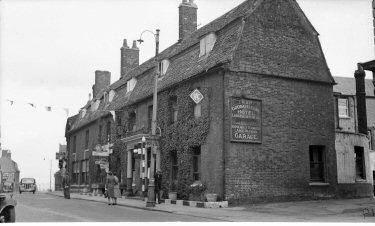 |
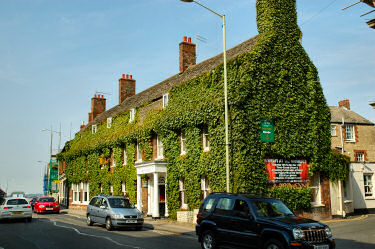 |
| The Goddard Arms Hotel on High Street in Old Town seems to have hardly changed, only the ivy seems to have grown quite a lot. But then again I believe it is cut back regularly and I might have only caught it at a good time. Only the rounded extension with the chimney on the right seems to have changed, the chimney is gone. | |
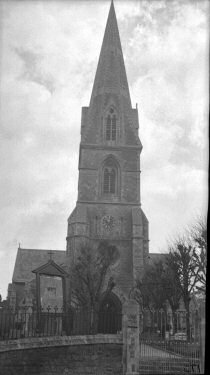 |
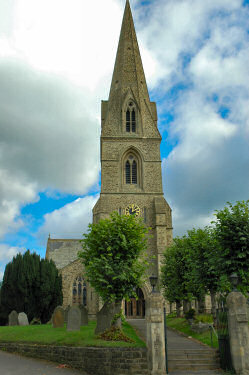 |
| Christ Church with St Mary's also seems to haven't changed much in the last 60 years, at least as far as the church itself is concerned. The notice board on the left has disappeared, there is a new one on the right of the gate (not visible in picture). Also the wall and fence on the left of the gate is gone, I assume to make space for the driveway leading to a car park. | |
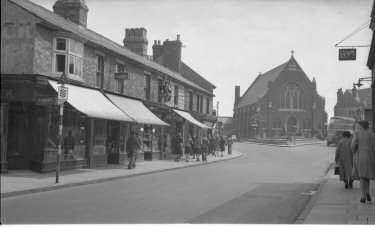 |
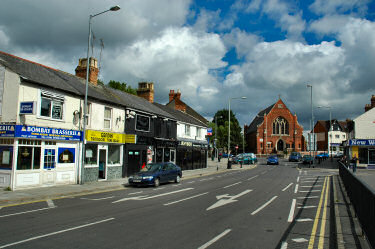 |
| Having walked down towards the new town, or the town centre, we look back at the corner of Regent Circus and Clarence Street (Clarence Street leads to Victoria Road, which leads into Old Town). While the buildings on the left and the church/hall still stand it looks like the road has been widened and the buildings on the right were demolished. There is now a car park on the right. The tenants of the buildings on the left have changed significantly though, where there was a chemist and a hardware store we now find a number of Indian restaurants and a 'gentlemans club with table side dancing'. | |
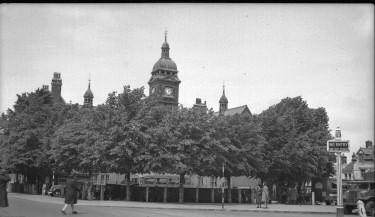 |
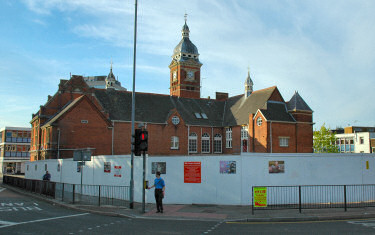 |
| Turning around we get the first view of the old 19th century Town Hall, looking at the back of it. The trees are gone, until fairly recently the place behind the building housed the central library in a 'temporary' building. That building has been demolished to make place for the New Central Library. The town hall building itself doesn't seem to have changed much from this side, but notice the missing chimney pipes. | |
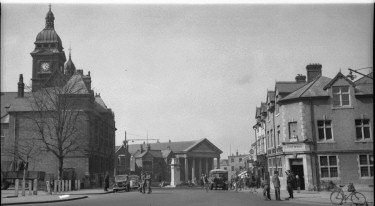 |
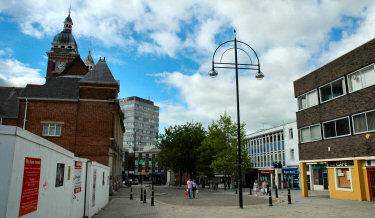 |
| We continue right for a better view of Regent Circus, which looks quite different now. The Town Hall building still looks very much unchanged, although there is a new window on the left. The cenotaph/ war memorial is still in the same place, although it is now under some trees. An ugly office building has risen behind the buildings on the other side of Regent Circus, judging from the design probably in the 1970s or 1980s. The Baptist Tabernacle wouldn't be visible even without the trees, it was demolished in 1978. Also the Post Office and the whole row of buildings on the right are long gone now, having been replaced by newer buildings. | |
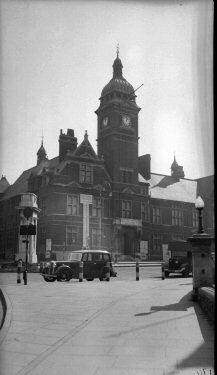 |
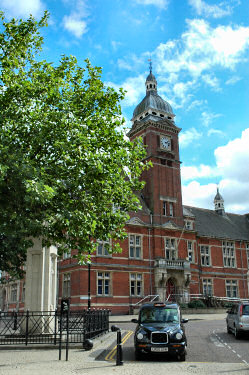 |
| We have now arrived at the front of the old Town Hall. The building seems to have had quite a few uses over the years: The banner over the door in the old picture reads 'Services Canteen'. Today it isn't used as a town hall either, instead it is home to Swindon Dance and cre8 studios. For some reason the flagpole seems to have moved from the top of the tower to the balcony above then entrance. The cenotaph/ war memorial seems unchanged apart from a fence having been erected around it and it now being sheltered by a tree. Oh, and the National Savings status board (the white 'thermometer' left of the entrance) and the wall on the right are gone. | |
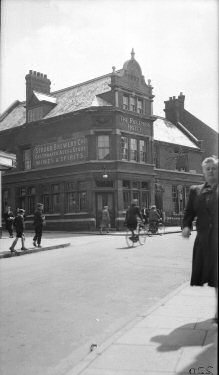 |
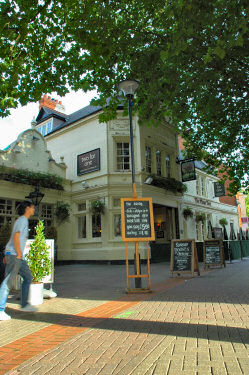 |
| Walking into Regent Street the first thing we notice is that the road has disappeared and the area is now a pedestrian zone. At first glance we also struggle to find The Rifleman's Hotel, but then that might be because it is now called The Plum Tree and because some fairly large trees now partly hide the old sign. The road leading off to the left has disappeared and has been replaced by a new entrance to the pub. And the large 'Stroud Brewery' sign on the side is gone. | |
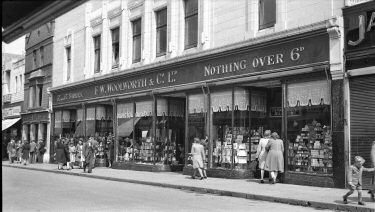 |
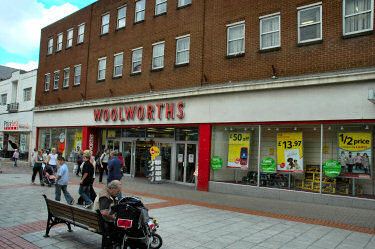 |
| We continue along Regent Street to reach the Woolworths Store. It has changed in a few aspects: The F.W. has been dropped from the name and it is now called Woolworths. With the currency decimalisation the prices have changed and with it the displays. The building itself has changed completely and has taken over the site of the dark building on the left, but the white building with the small balcony remains (although it now has a different tenant). | |
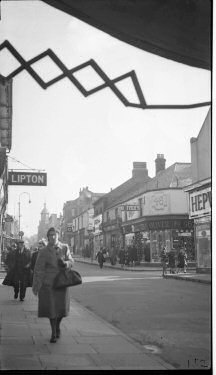 |
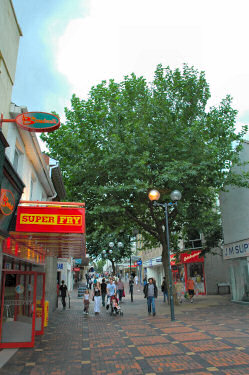 |
| Our walk finishes in Bridge Street, looking back towards Regent Street. We are at the corner with Queen Street and King Street. Same as Regent Street the area is now pedestrians only, trees obscure the view towards Regent Street. Most of the shops have changed and quite a few of the buildings look very different today. If you were able to look through the trees you wouldn't be able to see the tower of McIlroys department store, which has disappeared.
In February 2007 Simon sent me a picture of Bellevue Road in 1876, in particular he was interested in nr 26 where some of his ancestors had lived: “The house was home to my great grandparents Joseph and Louisa Osmond around 1876. Joseph's profession on his marriage certificate in 1874 is given as "Manufacturer".” I took a few pictures to give him the opportunity to see how it looks now: |
|
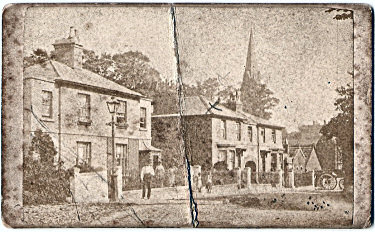 |
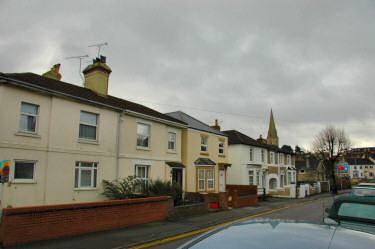 |
| The house doesn't seem to have changed very much (nr 26 is the one marked with the cross), although it seems a new house has been built between nr 26 and 27 at some point. You can see the spire of Christ Church in the background, but the horse cart has been replaced by cars.
If you are interested in more pictures from Swindon, you might also be interested in the following pages: |
|
 |
Back to top
Copyright © 2006-2007 Armin Grewe & James Max Porter/Carol Gilmore & Simon Thomson - FAQ |
 |